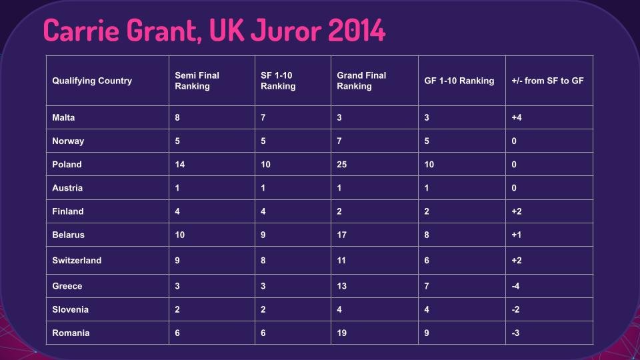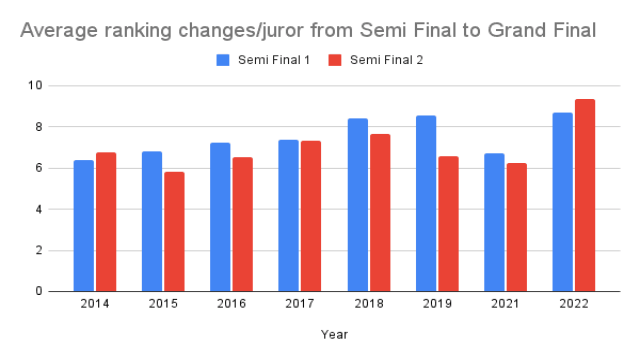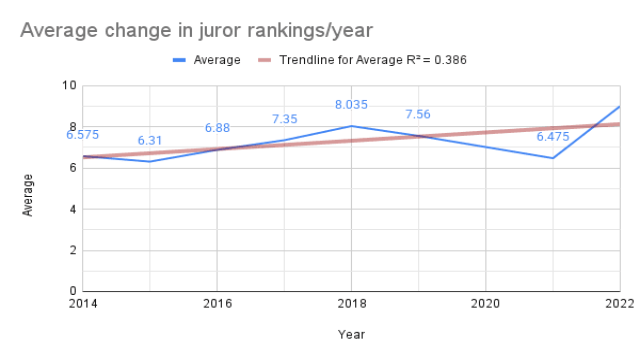At ESC Insight, we’ve long been curious about whether it makes a difference being drawn into Semi Final One or Two at Eurovision. Sure, there are logistical quirks, like broadcasters shelling out extra nights in pricey hotels for Semi One artists, but what about the competition itself? Does the draw influence how songs are perceived by the time we reach Saturday night?
Artists in Semi Final Two often arrive later but face a grueling performance week: two full dress rehearsals on Wednesday, the live Semi Final on Thursday, another full rehearsal on Friday for the jury, and the live Grand Final on Saturday. There’s eight full-on performances in four days, not to mention the notoriously early start on Friday morning for the Flag Parade rehearsal. Meanwhile, Semi Final One performers benefit from a slower build-up to the final, with more rest and, crucially, more time.
And time, in this contest, might just be everything. Because time isn’t just about energy and stamina; it’s also about perception. About momentum. About songs being heard, shared, and talked about. The more time you have between your Semi Final and the Grand Final, the more opportunity there is for viewers, and even jurors, to change their minds.
From Underdog to Champion
Consider KAJ’s incredible run at Melodifestivalen 2025. In their heat, they finished far behind Måns Zelmerlöw, with the 2015 Eurovision Song Contest winner being the first act to score the maximum 96 points in a Melodifestivalen heat. But over the weeks that followed, momentum began to build. ‘Bara Bada Bastu‘ became the talk of the contest, powered by fan support, social media, and its unique charm. By the time the final came around, KAJ had transformed from underdog to televote winner.
That transformation didn’t happen overnight. It was built in the space, the two week window, between those Melodifestivalen shows. So we asked the question: could a similar momentum swing happen at Eurovision? Could the extra three days between a Tuesday Semi Final and the Friday Jury Final make a difference?
Testing the Theory
To explore this, we looked to a familiar control group: the Eurovision juries. Eurovision’s professional juries vote in both the Semi Finals and the Grand Final, giving us a unique chance to measure how their rankings change over time. If jurors form first impressions in the Semi Finals, do they stick with them? Or does something shift by Friday night?
We returned to a research method we’ve used before, one we have used before when presenting for the Eurovision Academic Conference. We analysed juror data from 2014 to 2022* and looked at how individual jurors ranked the same songs between their assigned Semi Final and the Grand Final. For each juror, we counted how many position changes occurred in their ranking of those songs. One ranking swap counts as one point. More changes, higher score.

Presentation of how Carrie Grant’s votes changed from Semi Final to Grand Final in 2014
Take UK jury chairperson Carrie Grant in 2014. In her rankings, four songs shifted upward in the Grand Final compared to their Semi Final placements, resulting in a total of nine changed positions. That might sound high, but it’s far from unusual. In fact, only six jurors across nine years of data had zero changes.
What We Discovered

Bar chart showing the change/juror from Semi Final to Grand Final from 2014 to 2022 (Image: Ben Robertson, ESC Insight)
In six of the eight contests studied, jurors changed their rankings more for songs that came from Semi Final One than those from Semi Final Two. On average, Semi Final One jurors shifted songs by 7.53 places, compared to 7.02 for Semi Final Two. That’s a modest 7% difference.
Looking further at the songs most impacted, twelve of the twenty most-reshuffled songs in jury rankings came from Semi Final One. Furthermore, the top five most dramatically re-evaluated songs were All Tuesday qualifiers: ‘City Lights‘, ‘Fuego‘, and ‘Nobody But You‘ saw the biggest improvements, while ‘I’m Alive‘, and ‘Better Love‘ saw biggest drops from Semi Final to Grand Final with the juries.
However, it’s important not to overstate these findings. A statistical t-test showed that the difference is not significant (t-score of 0.13, which would need to be under 0.05 to prove a statistically significant different) in a scientific sense. The trend doesn’t carry strong enough mathematical confidence to declare it proven on its own. And that’s how it should be. Time isn’t the only factor. Running order, live performance differences, and audience engagement in the arena all matter just as much, if not more.
The Modern Effect
One pattern did stand out beyond the above: this change is increasing over time. Combining data from both Semi Finals, we saw that from 2014 to 2022, the average number of ranking changes per juror increased by 23%, from about 6.5 to nearly 8. The R² value of 0.386 suggests only a moderate trend, again, not enough to confidently state that the modern era is so drastically different, but enough to note this trend may be underlying behind the confusion of the Song Contest.

Graph demonstrating how the number of ranking changes per juror has increased on average from 2014 to 2022 (Image: Ben Robertson, ESC Insight)
So why is this happening more now? The obvious answer is social media. In 2014, we cringed at #JoinUs as hashtags were just becoming a thing. A decade later, Eurovision dominates social platforms. In 2024, in Eurovision week alone, TikTok content reached nearly 500 million accounts, YouTube views between shows hit 42 million, and Instagram reach doubled to 69 million compared to 2023.
Jurors are more likely to be people like us rather than robots stuck in a dark cupboard for all of Eurovision week, and as such they are also exposed to this flood of content. They rewatch performances, scroll through reactions, and absorb commentary, consciously or not. There is so much more to be influenced by in the modern age than there even was before.
What We Are Seeing
What we are witnessing is a well-known idea in political science, the “bias toward maintaining existing affect even in the face of disconfirming information.” In plain terms, it means people, including Eurovision jurors, often stick with their first impressions the first time they are exposed to something new. That something new could be two things. It could be the new live Eurovision performance, or the reactions of the public to it. When the Semi Finals arrive, many jurors might already have a mental scoreboard formed, or preconceived notions about what a good song should look and sound like. Even if a live performance challenges their expectations, there’s a natural pull to trust what they originally thought. Today’s world allows for any human to take in more of what the wider world is thinking.
So is it better to have been in Semi Final One? Not exactly. The difference is subtle. Time allows for perception to shift, and that can be for better or worse. If your act is unconventional, slow-burn, or benefits from a second look, then yes, those extra days can be your best friend. The three days between Tuesday and Friday are packed with influence. Thursday qualifiers? They get less than 24 hours before the jury show. It’s simply not the same build up.
Think of acts like KAJ in Sweden or Albania’s Shkodra Elektronike, bringing a performance with a staging concept beyond what we saw in the music video, finally on a scale and budget equal to its competitors. If jurors need time to warm up to something unexpected, or to have the public convince them that something is worthy, being in Semi Final One offers time for such reflection.

The Swiss performance, with zero camera cuts and plenty of intimacy, may take time for people to appreciate (Photo: Sarah Louise Bennett, EBU)
But that door swings both ways. More time means more scrutiny. A performance that doesn’t land might fade faster in the public eye. In the end, Semi Final One feels like the high-risk, high-reward option. Semi Final Two? Safer, steadier, perhaps more reliant on pre-existing support, at least in terms of success in the Grand Final.
In a year where the scoreboard could be tight, even the smallest influences might count. And time – that quiet, invisible factor – could be the difference. But it would be the difference because of all of us.
If one thing is clear to me investigating this, it’s that the collective voices of the Eurovision community, have more influence today to impact the Song Contest on the scoreboard.









